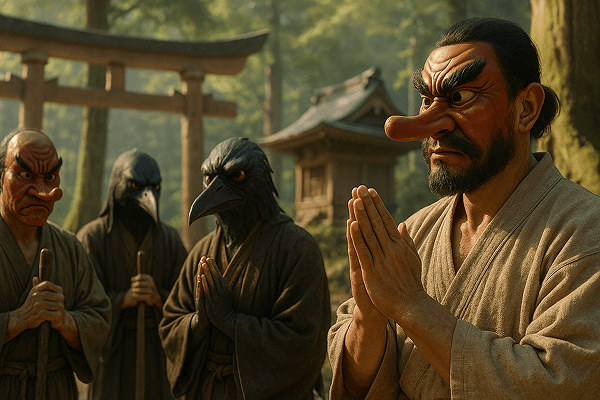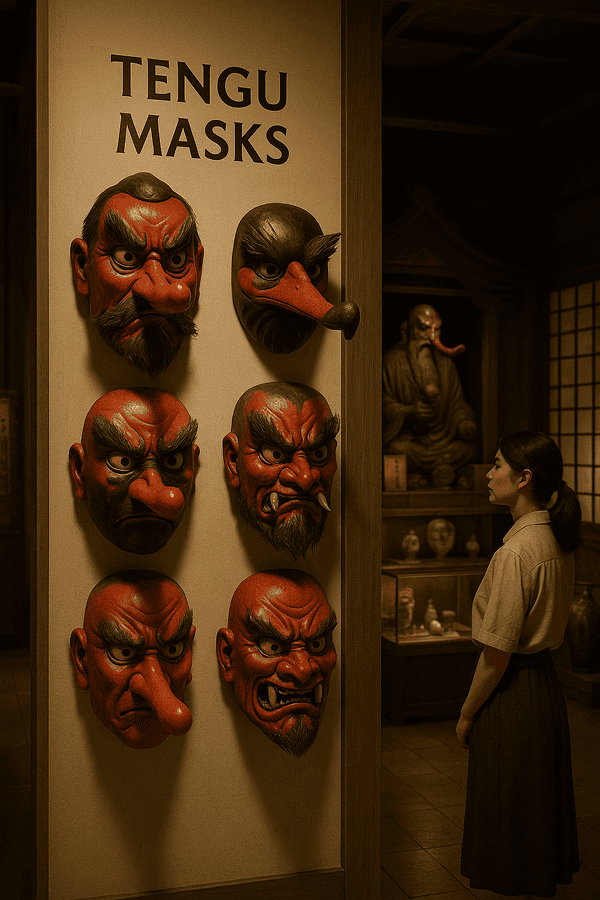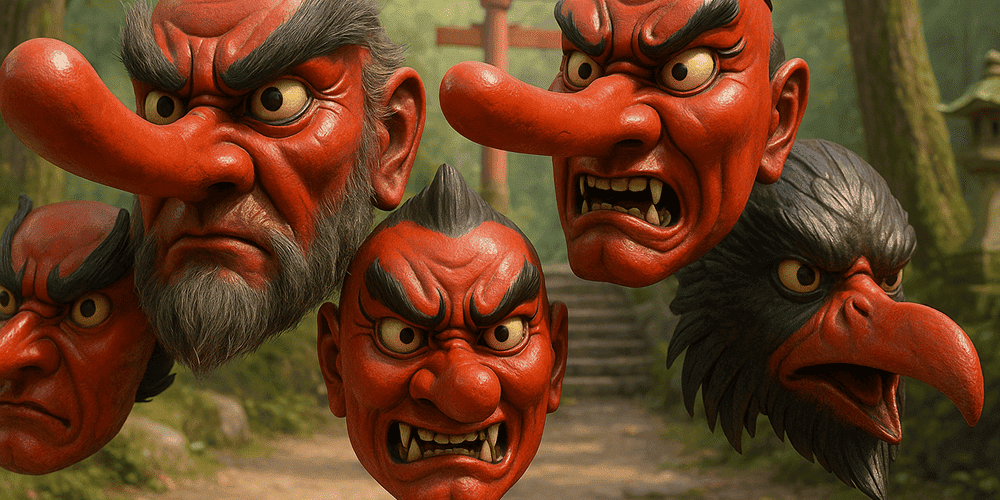Tengu Masks are among the most iconic and enigmatic traditional masks of Japan, instantly recognizable for their exaggerated features — especially the long, protruding nose and fierce, expressive eyes. Often painted in vivid red, with accents of black, white, and gold, Tengu Masks may also feature bushy eyebrows, sharp fangs, or even feathered details. These masks are deeply rooted in Japanese folklore and religious practice, embodying the mythical Tengu — supernatural beings that straddle the line between gods, demons, and mountain spirits. Tengu Masks are closely associated with the mountainous regions of Honshu and have been a part of Japanese culture since at least the Heian period (794–1185 CE), continuing to play a vital role in folk festivals, religious rituals, and traditional theater.
Historical Origins of Tengu Masks
The origin of Tengu Masks is intertwined with the evolution of the Tengu myth in Japanese folklore. The word “Tengu” (天狗) is thought to have been imported from the Chinese “Tiangou,” a dog-like celestial creature, but the Japanese Tengu quickly developed its own unique identity. Early depictions from the Heian and Kamakura periods show Tengu as bird-like beings, often with beaks, claws, and wings. Over time, their appearance shifted towards a more human form with a distinctive long nose — likely influenced by Noh and Kyogen theater traditions. The mask’s design evolved to reflect both fear and reverence, capturing the ambiguous nature of the Tengu as both trickster and protector. Tengu masks were originally used in religious rituals, Shugendo mountain ascetic practices, and folk performances, and references to their use appear in ancient scrolls, shrine records, and temple carvings. As with Samurai Masks, Tengu masks have evolved alongside Japan’s shifting cultural landscape, blending martial, spiritual, and theatrical influences.
Cultural Significance and Symbolism of Tengu Masks
In Japanese culture, Tengu Masks represent far more than mere costume accessories. The Tengu itself is a complex figure — sometimes portrayed as a disruptive demon who punishes arrogance, sometimes as a wise mountain hermit who bestows martial or spiritual knowledge. The mask’s long nose is both a symbol of pride and a visual cue for supernatural power. Tengu are believed to protect sacred forests and mountain temples, teach martial arts to worthy disciples, and punish those who disrespect the spiritual world. In Shinto and Buddhist contexts, Tengu are both feared and venerated, often invoked during rituals to guard against disaster or misfortune. Numerous legends surround the Tengu, such as their role in training legendary warriors or tricking impious monks. Wearing a Tengu Mask in ritual or performance confers a sense of transformation, allowing the wearer to embody the Tengu’s dual nature — part guardian, part trickster. Socially, Tengu Masks play an important role in community identity, local festivals, and the transmission of folklore across generations.

Materials and Techniques of Tengu Mask Making
Traditional Tengu Masks are crafted from a variety of materials, most commonly lightweight woods such as paulownia or cypress, but also papier-mâché, lacquer, or even metal for ceremonial versions. The process begins with carving the wood into a distinctive elongated face and prominent nose, followed by careful smoothing and painting. Artisans use chisels, knives, and brushes, often applying multiple layers of natural pigments for depth and durability. Lacquer or gold leaf may be added for special occasions. Some masks incorporate movable jaws, glass eyes, or actual feathers to enhance their dramatic impact. Regional workshops, especially in areas like Nara and Kyoto, have developed their own stylistic nuances — some favoring highly stylized, almost caricatured forms, others aiming for lifelike realism. Color symbolism is important: red for power and protection, black for mystery, and gold or white for spiritual purity. Decorative elements such as cords, bells, or straw may be added, reflecting the ritual or theatrical context.
Functions and Uses of Tengu Masks
Tengu Masks serve a wide range of ritualistic, theatrical, and festive purposes. In Shinto and Buddhist ceremonies, they are worn by priests, monks, or lay participants during rites to ward off evil spirits, bless the community, or mark seasonal transitions. Tengu Masks are central to folk festivals such as the Tengu Matsuri (Tengu Festival), where masked dancers perform acrobatic or comedic routines to honor the mountain spirits and entertain the crowd. In traditional theater, especially Noh and Kyogen, Tengu Masks help actors embody supernatural characters, blending drama, dance, and religious symbolism. Over the centuries, the use of Tengu Masks has expanded to include modern parades, martial arts demonstrations, and even pop-culture events. Today, they are collected as art objects, displayed in museums, and featured in contemporary performances, all while retaining their ritual resonance.
Regional Variations of Tengu Masks
Tengu Masks exhibit notable regional variations across Japan. In the Kanto region, masks tend to have a very pronounced, sharply pointed nose and fierce expressions, reflecting the local folklore. In Kansai, Tengu Masks are often larger, with exaggerated features and elaborate decoration, sometimes incorporating real feathers or hair. The mountainous areas of Tohoku and Chubu have their own interpretations, sometimes blending Tengu imagery with local deities or festival traditions. Some regions favor a more bird-like Tengu (Karasu Tengu), with beaked masks and avian motifs, while others emphasize the human-nosed (Hanadaka Tengu) form. Compared to other Asian mask traditions, Japanese Tengu Masks are unique for their blend of humor, fear, and spiritual ambiguity — distinct from the grandeur of Chinese guardian masks or the solemnity of Korean shamanic masks.
Famous Examples and Collections of Tengu Masks
Some of the most renowned Tengu Masks are housed in shrines, temples, and museums throughout Japan. The Kurama-dera Temple near Kyoto, legendary home of the Tengu king, displays impressive masks and effigies during the annual Kurama Fire Festival. The Tengu Museum in Mt. Takao (Tokyo) boasts a vast collection of historic and modern masks, as do the National Museum of Japanese History and the Kyoto National Museum. Historic finds include Edo-period Tengu Masks crafted for Kabuki and Noh performances, as well as masks used in Shugendo rituals. Private collectors and cultural organizations, along with online platforms like toddmasks.com, provide virtual access to Tengu Masks, helping to preserve and share this tradition with a wider audience.

Influence of Tengu Masks on Art and Culture
The Tengu Mask’s dramatic design and rich symbolism have left a significant mark on Japanese and global art. Tengu imagery appears in woodblock prints, ink paintings, sculpture, and contemporary manga and anime, often symbolizing the tension between human ambition and divine retribution. In literature, the Tengu serves as a metaphor for pride, wisdom, or the supernatural. Tengu Masks have inspired fashion designers, graphic artists, and filmmakers, and are frequently referenced in video games and modern pop culture. The connection between Tengu and martial prowess links these masks to the world of Samurai Masks, highlighting their influence on traditional Japanese martial arts and warrior iconography. The preservation and reinterpretation of Tengu Mask culture play a vital role in maintaining Japan’s rich artistic and spiritual heritage.
Contemporary Status and Preservation of Tengu Mask Traditions
Today, Tengu Mask making is alive and evolving, sustained by master craftsmen, cultural festivals, and educational programs. Artisans continue to create masks using traditional methods, often passing their skills down through family workshops or regional guilds. Festivals and museum exhibitions celebrate the enduring appeal of Tengu Masks, while modern artists experiment with new materials and digital techniques. Educational initiatives — sometimes featured on toddmasks.com — ensure that both Japanese and international audiences understand the history, artistry, and significance of Tengu Masks. Conservation efforts, scholarly research, and community events all contribute to the ongoing vitality of this tradition, ensuring that Tengu Masks remain a dynamic and relevant part of Japanese culture.
Collecting and Acquiring Tengu Masks
The market for Tengu Masks is active, with authentic pieces available from artisan studios, festival workshops, galleries, and reputable online sources. Antique or artist-signed masks are highly sought after by collectors and can command significant prices, especially those with documented provenance or historical association. Contemporary Tengu Masks are popular as decorative art, gifts, or performance props. Collectors should seek expert advice, verify authenticity, and support ethical, community-based sources. Toddmasks.com provides guidance on collecting, authentication, and the cultural context of Tengu Masks, helping ensure respectful and responsible acquisition. Ethical collecting preserves both the artistic value and spiritual meaning of these remarkable objects.
